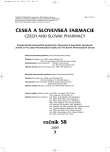A clinical study of the relationship of selenium plasma level to atopic dermatitis, a comparison of the results of determination using the methods of galvanostatic dissolution chronopotentiometry and atomic absorption spectrometry
Authors:
A. Planková; P. Mikuš; Emil Havránek
Authors‘ workplace:
Univerzita Komenského v Bratislave, Farmaceutická fakulta, Katedra farmaceutickej analýzy a nukleárnej farmácie, SR
Published in:
Čes. slov. Farm., 2009; 58, 109-115
Category:
Original Articles
Overview
In the human organism, the external factors of the environment, smoking and stress provoke the production of very reactive free particles – radicals. In the case of deficiency of suitable protective mechanisms in the organism, these reactive particles produce the conditions for the development of inflammatory diseases in the body. The human body possesses protective mechanisms of its own to defend the organisms against free radicals. From this viewpoint, particularly antioxidants, i.e. substances capable to neutralize free radicals, are of increased importance. One of the antioxidants of key importance is the nutritional element selenium, the importance of which has already been confirmed in a number of different studies 1). The present paper aimed to elaborate and optimize the working conditions in the identification and determination of selenium in blood plasma in patients suffering from atopic dermatitis, an inflammatory skin disease. The selenium values found in patients suffering from the above-mentioned disease were compared with the selenium values determined in a group of healthy subjects. The paper also aimed to evaluate the connection between a decreased selenium level and the organism and atopic dermatitis as well as to examine the influence of the administration of a preparation containing selenium upon the course of the disease. The procedure of measurement was verified by comparing the results of selenium content obtained by a more recent electrochemical analytical method – galvanostatic solution chronopotentiometry (SCP) – with the results obtained by a comparative method – hydrid generation atomic absorption spectrophotometry (HGAAS).
Key words:
selenium – antioxidative agents – galvanostatic solution chronopotentiometry – atopic dermatitis
Sources
1. Fairweather-Tait, S., Hurst, R.: Am. J. Clin. Nutr., 2009; 89, 927–928.
2. Guo, L., Jury, W. A., Frankerberger, W. T., Zhang, Y. Q.: J. Environ. Qual., 2000; 29, 1041–1048.
3. Lu, J., Holmgren, A.: J. Biol. Chem, 2009; 284, 723–727.
4. Štiková, O. et a kol.: Výzkumný ústav zemědělské ekonomiky pro Výskumný ústav potravinársky. Bratislava, Praha1998.
5. Kajaba, I., Šimončič, R., Ginter, E. a kol.: Vestník MZ SR, 45, čiastka 7–8, zo dňa 28. 04. 1997.
6. Hlava, P., Žemberyová, M., Kovács a kol.: Čs. Pediat., 1996; 51, 444–446.
7. Yoshinaga, J., Shirasaki, T., Oishi, K., Morita, M.: Anal.Chem., 1995; 67, 1568–1574.
8. Haid, J., Planková, A., Kolibášová, K., Havránek, E.: Čes.-slov. Derm., 2006; 81, 217.
9. Ranjbar A., Pizzulli A.: Int. Pediatrics, 2002; 16, 96–104.
10. Ou L. S., Goleva E., Hall C., Leung D. Y.: J. Allergy Clin. Immunol., 2004; 113, 756–763.
11 Kahay, J., Haid, J., Kočišová, M.: Nežiadúce účinky liekov na kožu. Martin: Osveta 1992, s. 173.
12. Haid, J., Danilla, T., Lidaj, J.: Dermatovenerologická propedeutika, e-learning. Bratislava: SZU, 2008.
13. Bózner, A.: Farmakologická propedeutika. Osveta: Martin 1988, s. 274.
14. Konvalina, J., Vytřas, K.: Chem. Listy, 2001; 95, s. 344–352.
15. EcaSenzor. Metodická príručka. Istran s.r.o., Bratislava, 1998, s. 43.
16. Matusiewicz, H., Sturgeon, R. E., Berman S. S.: J. Anal. At. Spectrom., 1991; 6, 283–287.
17. Maďarič, A., Kadrabová, J.: Farm. Obzor, 1997, LXVI; 259–262.
18. Eckschlager, K., Horsák, I., Kodejš, Z.: Vyhodnocování analytických výsledků a metod. Praha: SNTL 1980, s. 243.
Labels
Pharmacy Clinical pharmacologyArticle was published in
Czech and Slovak Pharmacy

2009 Issue 3
Most read in this issue
- Ointments in medieval Europe
- A short introduction to algal and cyanobacterial constituents – the occurrence of phenolic metabolites
- Review of hydroxamic matrix metalloproteinase inhibitors and their therapeutic potential
- A clinical study of the relationship of selenium plasma level to atopic dermatitis, a comparison of the results of determination using the methods of galvanostatic dissolution chronopotentiometry and atomic absorption spectrometry
